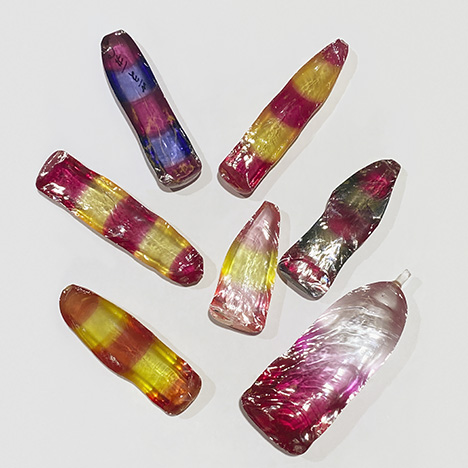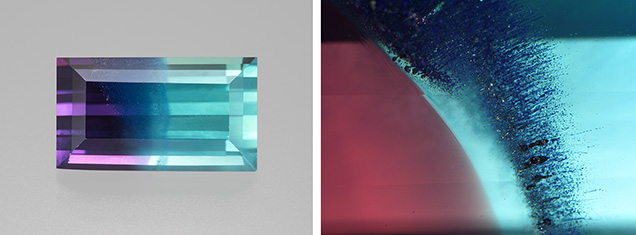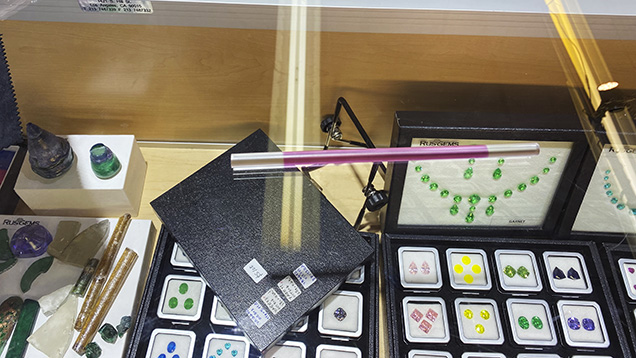Bicolor Synthetic Sapphire

At the JOGS show, a wide selection of synthetic gem materials was offered by the Bangkok office of RusGems, a synthetic crystal growth company out of Russia. Olga Tanskaia showed us their extensive color range of synthetic sapphire, spinel, beryl, garnet, and other lab-grown crystals produced using a variety of crystal growth methods. She noted that blue and red synthetic gems are always their best sellers.

As we found with natural sapphire this year, bicolor synthetic sapphire, both rough and cut, was also available and popular (figure 1). This material is grown by flame fusion, and the chromophore component of the powder composition is altered during the growth process at the desired length. Many different color combinations were available, including some with the popular teal blue and purple hues (figure 2, left). The inspiration for applying this method of color zoning to these flame-fusion grown crystals came from historical work on synthetic ruby laser rods where colorless (or “undoped”) regions were desired for the ends of the rods (figure 3). A process to grow a single crystal having pure aluminum oxide for a certain length, then adding the desired level of chromium to the growth for the laser rod portion of the length, and then returning to pure aluminum oxide was developed to achieve this.

We took the step-cut bicolor synthetic sapphire in figure 51 back to the GIA lab to determine the trace element chemistry responsible for generating the teal and purple hues. Using laser ablation–inductively coupled plasma–mass spectrometry (LA-ICP-MS), we found that the teal end contained no Be, Mg, Ti, V, Mn, Fe, or Ni but did contain small amounts of Cr and Ga (approximately 4 ppma and 0.5 ppma, respectively) and a substantial amount of Co (approximately 140 ppma). The purple end similarly contained no Be, Mg, V, Mn, Fe, or Ni but did contain small amounts of Ti (0.6 ppma) and Ga (0.4 ppma), with substantial amounts of Co (120 ppma), and Cr (470 ppma). Cobalt is giving this crystal the greenish blue component of its color, and chromium is modifying the hue to purple. We used UV-Vis spectroscopy to detect absorption peaks that could be used with the trace element chemistry to explain the two differently colored regions. We identified chromium peaks at approximately 400 and 560 nm responsible for the red color component in the purple half. We also identified an additional peak in the purple half at around 640 nm, likely due to Co3+. In the teal half, we did not find the Cr3+ peaks but did identify Co3+ peaks at 640 nm and at around 440 nm, and a peak around 600 nm due to Co2+ (K. Schmetzer and A. Peretti, “Characterization of a group of experimental Russian hydrothermal synthetic sapphires,” Journal of Gemmology, Vol. 27, No. 1, 2000, pp. 1–7).
In inspecting the inclusions at the boundary between the two differently colored portions, we discovered bright blue wisps of what we believe to be CoAl2O4 (figure 2, right), a spinel-structure material referred to as “cobalt blue” that is used to impart a blue color to glass, ceramics, and plastics.
The ability to generate just about any hue in sapphire, including color zoning, was readily apparent when looking through the offerings of RusGems. It was fascinating to see evidence of the direct influence of the high-tech laser industry on these synthetic gems.
.jpg)


